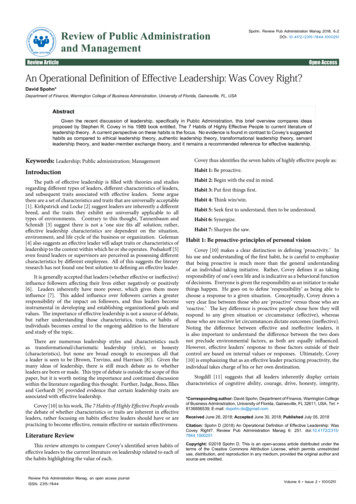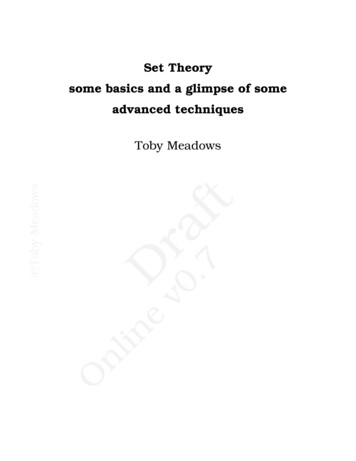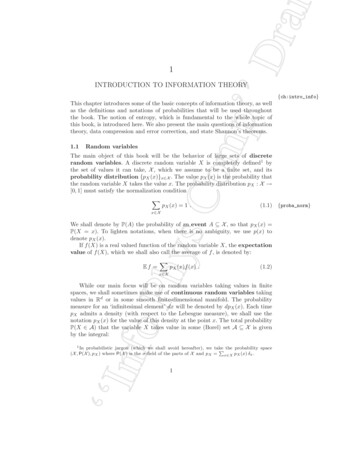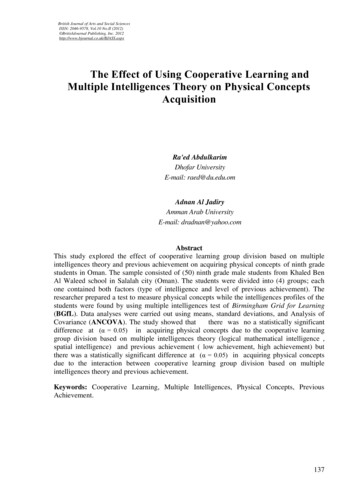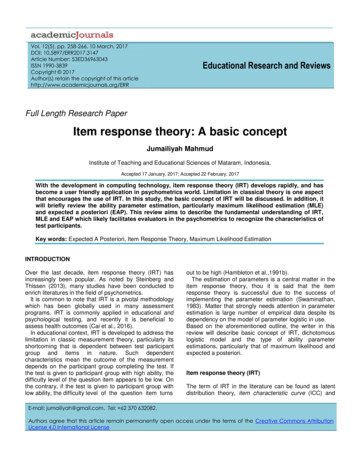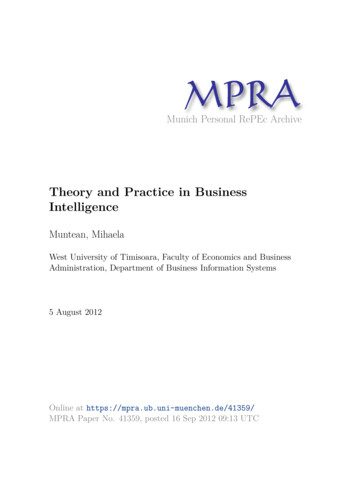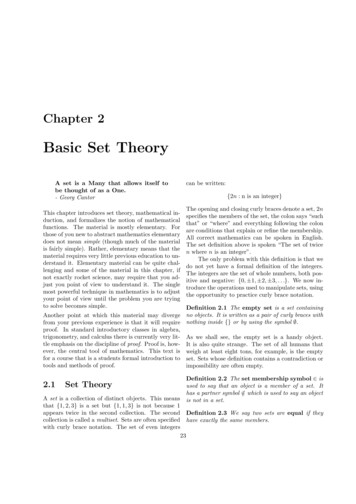
Transcription
Chapter 2Basic Set TheoryA set is a Many that allows itself tobe thought of as a One.- Georg CantorThis chapter introduces set theory, mathematical induction, and formalizes the notion of mathematicalfunctions. The material is mostly elementary. Forthose of you new to abstract mathematics elementarydoes not mean simple (though much of the materialis fairly simple). Rather, elementary means that thematerial requires very little previous education to understand it. Elementary material can be quite challenging and some of the material in this chapter, ifnot exactly rocket science, may require that you adjust you point of view to understand it. The singlemost powerful technique in mathematics is to adjustyour point of view until the problem you are tryingto solve becomes simple.Another point at which this material may divergefrom your previous experience is that it will requireproof. In standard introductory classes in algebra,trigonometry, and calculus there is currently very little emphasis on the discipline of proof. Proof is, however, the central tool of mathematics. This text isfor a course that is a students formal introduction totools and methods of proof.2.1Set Theorycan be written:{2n : n is an integer}The opening and closing curly braces denote a set, 2nspecifies the members of the set, the colon says “suchthat” or “where” and everything following the colonare conditions that explain or refine the membership.All correct mathematics can be spoken in English.The set definition above is spoken “The set of twicen where n is an integer”.The only problem with this definition is that wedo not yet have a formal definition of the integers.The integers are the set of whole numbers, both positive and negative: {0, 1, 2, 3, . . .}. We now introduce the operations used to manipulate sets, usingthe opportunity to practice curly brace notation.Definition 2.1 The empty set is a set containingno objects. It is written as a pair of curly braces withnothing inside {} or by using the symbol .As we shall see, the empty set is a handy object.It is also quite strange. The set of all humans thatweigh at least eight tons, for example, is the emptyset. Sets whose definition contains a contradiction orimpossibility are often empty.Definition 2.2 The set membership symbol isused to say that an object is a member of a set. Ithas a partner symbol / which is used to say an objectis not in a set.A set is a collection of distinct objects. This meansthat {1, 2, 3} is a set but {1, 1, 3} is not because 1appears twice in the second collection. The second Definition 2.3 We say two sets are equal if theycollection is called a multiset. Sets are often specified have exactly the same members.with curly brace notation. The set of even integers23
24CHAPTER 2. BASIC SET THEORYS T {1, 3, 5},Example 2.1 IfS {1, 2, 3}then 3 S and 4 / S. The set membership symbolis often used in defining operations that manipulatesets. The setT {2, 3, 1}is equal to S because they have the same members: 1,2, and 3. While we usually list the members of a setin a “standard” order (if one is available) there is norequirement to do so and sets are indifferent to theorder in which their members are listed.Definition 2.4 The cardinality of a set is its size.For a finite set, the cardinality of a set is the numberof members it contains. In symbolic notation the sizeof a set S is written S . We will deal with the ideaof the cardinality of an infinite set later.Example 2.2 Set cardinalityFor the set S {1, 2, 3} we show cardinality by writing S 3S U {2, 3, 5}, andT U {3, 4, 5}Definition 2.6 If A and B are sets and A B then we say that A and B are disjoint, or disjointsets.Definition 2.7 The union of two sets S and T isthe collection of all objects that are in either set. Itis written S T . Using curly brace notionS T {x : (x S) or (x T )}The symbol or is another Boolean operation, one thatis true if either of the propositions it joins are true.Its symbolic equivalent is which lets us re-write thedefinition of union as:S T {x : (x S) (x T )}Example 2.4 Unions of sets.Suppose S {1, 2, 3}, T {1, 3, 5}, and U {2, 3, 4, 5}.We now move on to a number of operations on sets. Then:You are already familiar with several operations on S T {1, 2, 3, 5},numbers such as addition, multiplication, and negation.S U {1, 2, 3, 4, 5}, andDefinition 2.5 The intersection of two sets S andT is the collection of all objects that are in both sets.It is written S T . Using curly brace notationS T {x : (x S) and (x T )}The symbol and in the above definition is an example of a Boolean or logical operation. It is onlytrue when both the propositions it joins are also true.It has a symbolic equivalent . This lets us write theformal definition of intersection more compactly:S T {x : (x S) (x T )}Example 2.3 Intersections of setsSuppose S {1, 2, 3, 5},T {1, 3, 4, 5}, and U {2, 3, 4, 5}.Then:T U {1, 2, 3, 4, 5}When performing set theoretic computations, youshould declare the domain in which you are working.In set theory this is done by declaring a universal set.Definition 2.8 The universal set, at least for agiven collection of set theoretic computations, is theset of all possible objects.If we declare our universal set to be the integers then{ 21 , 32 } is not a well defined set because the objectsused to define it are not members of the universalset. The symbols { 21 , 23 } do define a set if a universalset that includes 12 and 23 is chosen. The problemarises from the fact that neither of these numbers areintegers. The universal set is commonly written U.Now that we have the idea of declaring a universalset we can define another operation on sets.
252.1. SET THEORY2.1.1Venn DiagramsA Venn diagram is a way of depicting the relationshipbetween sets. Each set is shown as a circle and circlesoverlap if the sets intersect.Example 2.5 The following are Venn diagrams forthe intersection and union of two sets. The shadedparts of the diagrams are the intersections and unionsrespectively.notation for not is . There is not much savings inspace as the definition of compliment becomesS c {x : (x S)}Example 2.6 Set Compliments(i) Let the universal set be the integers. Then thecompliment of the even integers is the odd integers.(ii) Let the universal set be {1, 2, 3, 4, 5}, then thecompliment of S {1, 2, 3} is S c {4, 5} whilethe compliment of T {1, 3, 5} is T c {2, 4}.(iii) Let the universal set be the letters {a, e, i, o, u, y}.Then {y}c {a, e, i, o, u}.The Venn diagram for Ac isA BAcA BNotice that the rectangle containing the diagram islabeled with a U representing the universal set.Definition 2.9 The compliment of a set S is thecollection of objects in the universal set that are notin S. The compliment is written S c . In curly bracenotationS c {x : (x U) (x / S)}or more compactly asS c {x : x / S}We now have enough set-theory operators to use themto define more operators quickly. We will continue togive English and symbolic definitions.Definition 2.10 The difference of two sets S andT is the collection of objects in S that are not in T .The difference is written S T . In curly brace notationS T {x : x (S (T c ))},or alternatelyS T {x : (x S) (x / T )}Notice how intersection and complementation can beused together to create the difference operation andthat the definition can be rephrased to use Booleanoperations. There is a set of rules that reduces theThere is also a Boolean symbol associated with the number of parenthesis required. These are called opcomplementation operation: the not operation. The erator precedence rules.however it should be apparent that the compliment ofa set always depends on which universal set is chosen.
26CHAPTER 2. BASIC SET THEORY(i) Other things being equal, operations are per- Another important tool for working with sets is theformed left-to-right.ability to compare them. We have already definedwhat it means for two sets to be equal, and so by(ii) Operations between parenthesis are done first, implication what it means for them to be unequal.starting with the innermost of nested parenthe- We now define another comparator for sets.sis.Definition 2.12 For two sets S and T we say that(iii) All complimentations are computed next.S is a subset of T if each element of S is also an(iv) All intersections are done next.element of T . In formal notation S T if for allx S we have x T .(v) All unions are performed next.If S T then we also say T contains S which(vi) Tests of set membership and computations,canbewritten T S. If S T and S 6 T then weequality or inequality are performed last.write S T and we say S is a proper subset of T .Special operations like the set difference or thesymmetric difference, defined below, are not included Example 2.9 Subsetsin the precedence rules and thus always use paren- If A {a, b, c} then A has eight different subsets:thesis. {a}{b}{c}Example 2.7 Operator precedenceSince complementation is done before intersectionthe symbolic definition of the difference of sets can berewritten:S T {x : x S T c }If we were to take the set operationsA B Ccand put in the parenthesis we would get(A (B (C c )))Definition 2.11 The symmetric difference oftwo sets S and T is the set of objects that are in oneand only one of the sets. The symmetric difference iswritten S T . In curly brace notation:S T {(S T ) (T S)}Example 2.8 Symmetric differencesLet S be the set of non-negative multiples of two thatare no more than twenty four. Let T be the nonnegative multiples of three that are no more thantwenty four. ThenS T {2, 3, 4, 8, 9, 10, 14, 15, 16, 20, 21, 22}{a, b}{a, c}{b, c}{a, b, c}Notice that A A and in fact each set is a subset ofitself. The empty set is a subset of every set.We are now ready to prove our first proposition.Some new notation is required and we must introduce an important piece of mathematical culture. Ifwe say “A if and only if B” then we mean that eitherA and B are both true or they are both false in anygiven circumstance. For example: “an integer x iseven if and only if it is a multiple of 2”. The phrase“if and only if” is used to establish logical equivalence. Mathematically, “A if and only if B” is a wayof stating that A and B are simply different waysof saying the same thing. The phrase “if and onlyif” is abbreviated iff and is represented symbolicallyas the double arrow . Proving an iff statement isdone by independently demonstrating that each maybe deduced from the other.Proposition 2.1 Two sets are equal if and only ifeach is a subset of the other. In symbolic notation:(A B) (A B) (B A)Proof:Another way to think about this is that we need numbers that are positive multiples of 2 or 3 (but not both) Let the two sets in question be A and B. Begin byassuming that A B. We know that every set isthat are no more than 24.
272.1. SET THEORYa subset of itself so A A. Since A B we maysubstitute into this expression on the left and obtainB A. Similarly we may substitute on the right andobtain A B. We have thus demonstrated that ifA B then A and B are both subsets of each other,giving us the first half of the iff.Assume now that A B and B A. Thenthe definition of subset tells us that any element ofA is an element of B. Similarly any element of Bis an element of A. This means that A and B havethe same elements which satisfies the definition of setequality. We deduce A B and we have the secondhalf of the iff. 2where it is false. It is thus possible for a false mathematical statement to be “true most of the time”. Inthe next chapter we will develop the theory of primenumbers. For now we will assume the reader has amodest familiarity with the primes. The statement“Prime numbers are odd” is false once, because 2 is aprime number. All the other prime numbers are odd.The statement is a false one. This very strict definition of what makes a statement true is a conventionin mathematics. We call 2 a counter example. It isthus necessary to find only one counter-example todemonstrate a statement is (mathematically) false.A note on mathematical grammar: the symbol 2 indicates the end of a proof. On a paper turned in by astudent it is usually taken to mean “I think the proofends here”. Any proof should have a 2 to indicate itsend. The student should also note the lack of calculations in the above proof. If a proof cannot be readback in (sometimes overly formal) English then it isprobably incorrect. Mathematical symbols should beused for the sake of brevity or clarity, not to obscuremeaning.Example 2.10 Disproof by counter exampleProve that the statement A B A B is false.Proposition 2.2 De Morgan’s Laws Supposethat S and T are sets. DeMorgan’s Laws state that(i) (S T )c S c T c , and(ii) (S T )c S c T c .Proof:cLet A {1, 2} and B {3, 4}. Then A B while A B {1, 2, 3, 4}. The sets A and B form acounter-example to the statement.ProblemsProblem 2.1 Which of the following are sets? Assume that a proper universal set has been chosen andanswer by listing the names of the collections of objects that are sets. Warning: at least one of theseitems has an answer that, while likely, is not 100%certain.(i) A {2, 3, 5, 7, 11, 13, 19}(ii) B {A, E, I, O, U }Let x (S T ) ; then x is not a member of S or T . Since x is not a member of S we see that x (iii) C { x : x 0}S c . Similarly x T c . Since x is a member of boththese sets we see that x S c T c and we see that (iv) D {1, 2, A, 5, B, Q, 1, V }(S T )c S c T c . Let y S c T c . Then the(v) E is the list of first names of people in the 1972definition of intersection tells us that y S c andphone book in Lawrence Kansas in the ordery T c . This in turn lets us deduce that y is not athey appear in the book. There were more thanmember of S T , since it is not in either set, and35,000 people in Lawrence that year.so we see that y (S T )c . This demonstrates thatS c T c (S T )c . Applying Proposition 2.1 we get (vi) F is a list of the weight, to the nearest kilogram,that (S T )c S c T c and we have proven part (i).of all people that were in Canada at any time inThe proof of part (ii) is left as an exercise. 22007.In order to prove a mathematical statement you mustprove it is always true. In order to disprove a mathe- (vii) G is a list of all weights, to the nearest kilogram,that at least one person in Canada had in 2007.matical statement you need only find a single instance
28CHAPTER 2. BASIC SET THEORYProblem 2.2 Suppose that we have the set U {n : 0 n 100} of whole numbers as ouruniversal set. Let P be the prime numbers in U ,let E be the even numbers in U , and let F {1, 2, 3, 5, 8, 13, 21, 34, 55, 89}. Describe the followingsets either by listing them or with a careful Englishsentence.(i) E c ,(ii) P F ,(iii) P E,(iv) F E F E c , andc(v) F F .Problem 2.5 Find an example of an infinite set thathas a finite complement, be sure to state the universalset.Problem 2.6 Find an example of an infinite set thathas an infinite complement, be sure to state the universal set.Problem 2.7 Add parenthesis to each of the following expressions that enforce the operator precedencerules as in Example 2.7. Notice that the first three describe sets while the last returns a logical value (trueof false).(i) A B C D(ii) A B C DProblem 2.3 Suppose that we take the universal set (iii) Ac B c CU to be the integers. Let S be the even integers, letT be the integers that can be obtained by tripling any (iv) A B A Cone integer and adding one to it, and let V be the setProblem 2.8 Give the Venn diagrams for the folof numbers that are whole multiples of both two andlowing sets.three.(i) A B (ii) B A (iii) Ac B(i) Write S, T , and V using symbolic notation.(iv) A B (v) (A B)c (vi) Ac B c(ii) Compute S T , S V and T V and give symbolic representations that do not use the symbolsUS, T , or V on the right hand side of the equalssign.Problem 2.4 Compute the cardinality of the following sets. You may use other texts or the internet.A27(i) Two digit positive odd integers.5(ii) Elements present in a sucrose molecule.(iii) Isotopes of hydrogen that are not radioactive.(iv) Planets orbiting the same star as the planet youare standing on that have moons. Assume thatPluto is a minor planet.B31604C(v) Elements with seven electrons in their valenceProblem 2.9 Examine the Venn diagram above.shell. Remember that Ununoctium was discovered in 2002 so be sure to use a relatively recent Notice that every combination of sets has a uniquenumber in common. Construct a similar collectionreference.of four sets.(vi) Subsets of S {a, b, c, d} with cardinality 2.Problem 2.10 Read Problem 2.9. Can a system of(vii) Prime numbers whose base-ten digits sum to ten. sets of this sort be constructed for any number of sets?Be careful, some have three digits.Explain your reasoning.
292.2. MATHEMATICAL INDUCTIONProblem 2.11 Suppose we take the universal set tobe the set of non-negative integers. Let E be theset of even numbers, O be the set of odd numbersand F {0, 1, 2, 3, 5, 8, 13, 21, 34, 89, 144, .} be theset of Fibonacci numbers. The Fibonacci sequence is0, 1, 1, 2, 3, 5, 8, . . . in which the next term is obtainedby adding the previous two.(i) Prove that the intersection of F with E and Oare both infinite.2.2Mathematical InductionMathematical induction is a technique used in proving mathematical assertions. The basic idea of induction is that we prove that a statement is true in onecase and then also prove that if it is true in a givencase it is true in the next case. This then permits thecases for which the statement is true to cascade fromthe initial true case. We will start with the mathematical foundations of induction.(ii) Make a Venn diagram for the sets E, F , and O, We assume that the reader is familiar with the symand explain why this is a Mickey-Mouse problem. bols , , and . From this point on we willdenote the set of integers by the symbol Z. TheProblem 2.12 A binary operation is commuta- non-negative integers are called the natural numbers.tive if x y y x. An example of a commuta- The symbol for the set of natural numbers is N. Anytive operation is multiplication. Subtraction is non- mathematical system rests on a foundation of axioms.commutative. Determine, with proof, if union, inter- Axioms are things that we simply assume to be true.section, set difference, and symmetric difference are We will assume the truth of the following principle,commutative.adopting it as an axiom.Problem 2.13 An identity for an operation is The well-ordering principle: Every non-empty an object i so that, for all objects x, i x x i set of natural numbers contains a smallestelement.x. Find, with proof, identities for the operations setunion and set intersection.The well ordering principle is an axiom thatagrees with the common sense of most people familProblem 2.14 Prove part (ii) of Proposition 2.2.iar with the natural numbers. An empty set doesnot contain a smallest member because it containsProblem 2.15 Prove thatno members at all. As soon as we have a set of natA (B C) (A B) Cural numbers with some members then we can orderthose members in the usual fashion. Having orderedProblem 2.16 Prove thatthem, one will be smallest. This intuition agreeingA (B C) (A B) Cwith this latter claim depends strongly on the factthe integers are “whole numbers” spaced out in inProblem 2.17 Prove thatcrements of one. To see why this is important consider the smallest positive distance. If such a distanceA (B C) (A B) Cexisted, we could cut it in half to obtain a smallerProblem 2.18 Disprove thatdistance - the quantity contradicts its own existence.The well-ordering principle can be used to prove theA (B C) (A B) Ccorrectness of induction.Problem 2.19 Consider the set S {1, 2, 3, 4}. Foreach k 0, 1, . . . , 4 how many k element subsets does Theorem 2.1 Mathematical Induction I Suppose that P (n) is a proposition that it either true orS have?false for any given natural numbers n. IfProblem 2.20 Suppose we have a set S with n 0elements. Find a formula for the number of different (i) P (0) is true and,subsets of S that have k elements.(ii) when P (n) is true so is P (n 1)Problem 2.21 For finite sets S and T , proveThen we may deduce that P (n) is true for any natural S T S T S T number.
30CHAPTER 2. BASIC SET THEORYProof:induction that the proposition is true for all naturalnumbers. 2Assume that (i) and (ii) are both true statements. Let S be the set of all natural numbers forwhich P (n) is false. If S is empty then we are done,so assume that S is not empty. Then, by the wellordering principle, S has a least member m. By (i)above m 6 0 and so m 1 is a natural number. Sincem is the smallest member of S it follows that P (m 1)is true. But this means, by (ii) above, that P (m) istrue. We have a contradiction and so our assumptionthat S 6 must be wrong. We deduce S is emptyand that as a consequence P (n) is true for all n N.2The set of all subsets of a given set is itself an important object and so has a name.The technique used in the above proof is called proofby contradiction. We start by assuming the logicalopposite of what we want to prove, in this case thatthere is some m for which P (m) is false, and fromthat assumption we derive an impossibility. If an assumption can be used to demonstrate an impossibilitythen it is false and its logical opposite is true.A nice problem on which to demonstrate mathematical induction is counting how many subsets a finiteset has.Proposition 2.3 Subset counting. A set S withn elements has 2n subsets.Proof:First we check that the proposition is true whenn 0. The empty set has exactly one subset: itself. Since 20 1 the proposition is true for n 0.We now assume the proposition is true for some n.Suppose that S is a set with n 1 members and thatx S. Then S {x} (the set difference of S and a set{x} containing only x) is a set of n elements and so,by the assumption, has 2n subsets. Now every subsetof S either contains x or it fails to. Every subset of Sthat does not contain x is a subset of S {x} and sothere are 2n such subsets of S. Every subset of S thatcontains x may be obtained in exactly one way fromone that does not by taking the union with {x}. Thismeans that the number of subsets of S containing orfailing to contain x are equal. This means there are2n subsets of S containing x. The total number ofsubsets of S is thus 2n 2n 2n 1 . So if we assumethe proposition is true for n we can demonstrate thatit is also true for n 1. It follows by mathematicalDefinition 2.13 The set of all subsets of a set Sis called the powerset of S. The notation for thepowerset of S is P(S).This definition permits us to rephrase Proposition 2.3as follows: the power set of a set of n elements hassize 2n .Theorem 2.1 lets us prove propositions that are trueon the natural numbers, starting at zero. A smallmodification of induction can be used to prove statements that are true only for those n k for anyinteger k. All that is needed is to use induction ona proposition Q(n k) where Q(n k) is logicallyequivalent to P (n). If Q(n k) is true for n k 0then P (n) is true for n k and we have the modifiedinduction. The practical difference is that we startwith k instead of zero.Example 2.11 Prove that n2 2n for all n 2.Notice that 22 4 2 2 so the proposition is truewhen n 2. We next assume that P (n) is true forsome n and we compute:n2 n2 2n 1 (n 1)2(n 1)2(n 1)2(n 1)2 2n2n 2n 12n 2n 12n 1 12n 22(n 1)To move from the third step to the fourth step weuse the fact that 2n 1 when n 2. The last stepis P (n 1), which means we have deduced P (n 1)from P (n). Using the modified form of induction wehave proved that n2 2n for all n 2.It is possible to formalize the procedure for usingmathematical induction into a three-part process.Once we have a proposition P (n),
312.2. MATHEMATICAL INDUCTION(i) First demonstrate a base case by directly demonstrating P (k),(ii) Next make the induction hypothesis that P (n) istrue for some n,(iii) Finally, starting with the assumption that P (n)is true, demonstrate P (n 1).These steps permit us to deduce that P (n) is true forall n k.Example 2.12 Using induction, prove1 2 ··· n 1n(n 1)2In this case P (n) is the statementup lists of numbers. If we wished to sum some formula f (i) over a range from a to b, that is to saya i b, then we write :bXf (i)i aOn the other hand if S is a set of numbers and wewant to add up f (s) for all s S we write:Xf (s)s SThe result proved in Example 2.12 may be stated inthe following form using sigma notation.nXi 1i 1n(n 1)2Proposition 2.4 Suppose that c is a constant andthat f (i) and g(i) are formulas. ThenPbPbPb(i)i a g(i)i a f (i) i a (f (i) g(i)) PbPbPbBase case: 1 21 1(1 1), so P (1) is true. Induc(ii)i a g(i)i a f (i) i a (f (i) g(i)) tion hypothesis: for some n,PbPb(iii)i a f (i).i a c · f (i) c ·11 2 · · · n n(n 1)Proof:211 2 · · · n n(n 1)2Compute:1 2 · · · (n 1) 1 2 · · · n (n 1)1n(n 1) (n 1)21(n(n 1) 2(n 1))2 1 2n 3n 221(n 1)(n 2)21(n 1)((n 1) 1)2and so we have shown that if P (n) is true then so isP (n 1). We have thus proven that P (n) is true forall n 1 by mathematical induction.Part (i) and (ii) are both simply the associativelaw for addition: a (b c) (a b) c applied manytimes. Part (iii) is a similar multiple application ofthe distributive law ca cb c(a b). 2The sigma notation lets us work with indefinitely long(and even infinite) sums. There are other similar notations. If A1 , A2 , . . . , An are sets then the intersection or union of all these sets can be written:n\Aii 1n[Aii 1Similarly if f (i) is a formula on the integers thennYi 1f (i)We now introduce sigma notation which makes problems like the one worked in ExampleP 2.12 easier to is the notation for computing the product f (1) · f (2) ·state and manipulate. The symbolis used to add · · · · f (n). This notation is called Pi notation.
32CHAPTER 2. BASIC SET THEORYDefinitionP 2.14 When we solve an expressionPinvolvingto obtain a formula that does not useor”. . .” as in Example 2.12 then we say we have found aclosed form for thePn expression. Example 2.12 findsa closed form for i 1 i.Problem 2.24 Suppose that X Y with Y nand X m. Compute the number of subsets of Ythat contain X.Problem 2.25 Compute the following sums.P20i 1 i,At this point we introduce a famous mathematical (i)P30sequence in order to create an arena for practicing (ii)i 10 i, andproofs by induction.P21(iii)i 20 i.Definition 2.15 The Fibonacci numbers are defined as follows. f1 f2 1 and, for n 3, Problem 2.26 Using mathematical induction, provethe following formulas.fn fn 1 fn 2 .PnExample 2.13 The Fibonacci numbers with four or (i)i 1 1 n,Pn 2 n(n 1)(2n 1)fewer digits are: f1 1, f2 1, f3 2, f4 3,, andi 1 i 6f5 5, f6 8, f7 13, f8 21, f9 34, f10 55, (ii)Pn 3 n2 (n 1)2f11 89, f12 144, f13 233, f14 377, f15 .(iii)i 1 i 4610, f16 987, f17 1597, f18 2584, f19 4181,and f20 6765.Problem 2.27 If f (i) and g(i) are formulas and cExample 2.14 Prove that the Fibonacci number f3nis even.Solution:and d are constants prove thatbXi a(c · f (i) d · g(i)) c ·bXi af (i) d ·bXg(i)i aNotice that f3 2 and so the proposition is truewhen n 1. Assume that the proposition is true forsome n 1. Then:f3(n 1) f3n 3(2.1) f3n 2 f3n 1f3n 1 f3n f3n 1(2.2)(2.3)(2.4) Problem 2.28 Suppose you want to break an n mchocolate bar, like the 6 4 example shown above,but this suffices because f3n is even by the induction into pieces corresponding to the small squares shown.hypothesis while 2·f3n 1 is also even. The sum is thus What is the minimum number of breaks you caneven and so f3(n 1) is even. If follows by induction make? Prove your answer is correct.that f3n is even for all n. 2Problem 2.29 Prove by induction that the sum ofthe first n odd numbers equals n2 . 2 · f3n 1 f3nProblemsProblem 2.22 Suppose that S {a, b, c}. Computeand list explicitly the members of the powerset, P(S).Problem 2.23 Prove that for a finite set X that X P(X) Problem 2.30 Compute the sum of the first n positive even numbers.Problem 2.31 Find a closed form fornXi 1i2 3i 5
332.3. FUNCTIONSProblem 2.32 Let f (n, 3) be the number of subsets Problem 2.41 Consider the statement “All cars areof {1, 2, . . . , n} of size 3. Using induction, prove that the same color.” and the following “proof ”.f (n, 3) 61 n(n 1)(n 2).Proof:Problem 2.33 Supposethat wehavesetsX1 , X2 , . . . , Xn and Y1 , Y2 , . . . , Yn such that Xi Yi .Prove that the intersection of all the Xi is a subsetof the intersection of all the Yi :n\i 1Xi n\Yii 1Problem 2.34 Suppose that S1 , S2 , . . . Sn are sets.Prove the following generalization of DeMorgan’slaws:TnSnc(i) ( i 1 Si ) i 1 Sic , andTnSnc(ii) ( i 1 Si ) i 1 Sic .Problem 2.35 Prove by induction that the Fibonacci number f4n is a multiple of 3.Problem 2.36 Prove that if r is a real number r 6 1and r 6 0 thennXi 0ri 1 rn 11 rProblem 2.37 Prove by induction that the Fibonacci number f5n is a multiple of 5.Problem 2.38 Prove by induction that the Fibonacci number fn has the value !n !n 1 51 555 ··fn 5252Problem 2.39 Prove that for sufficiently large n theFibonacci number fn is the integer closest to !n 5 1 552and compute the exact value of f30 . Show your work(i.e. don’t look the result up on the net).Problem 2.40 Prove that n(n 1)(n 2)(n 3)is a24whole number for any whole number n.We will prove for n 1 th
Basic Set Theory A set is a Many that allows itself to be thought of as a One. - Georg Cantor This chapter introduces set theory, mathematical in-duction, and formalizes the notion of mathematical functions. The material is mostly elementary. For those of you new to abstract mathematics ele




